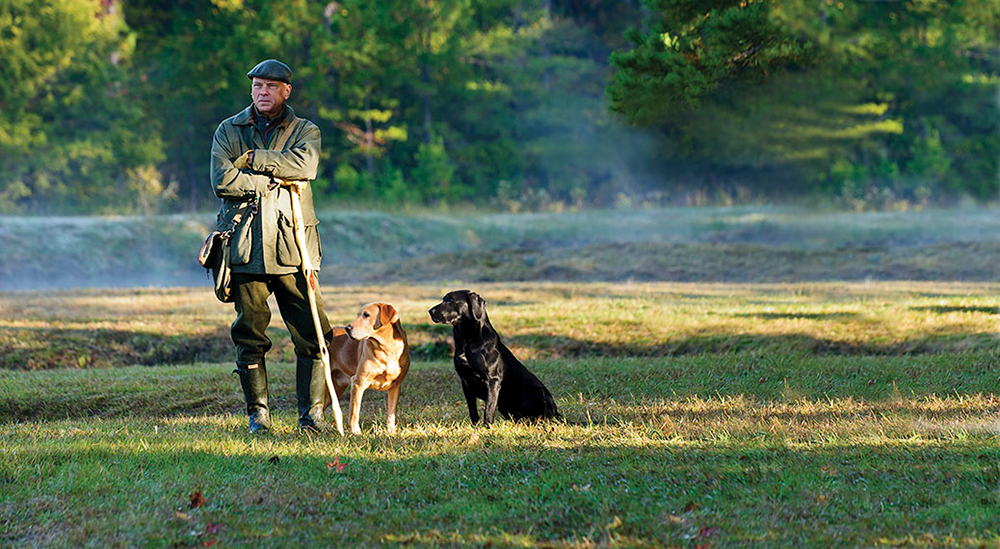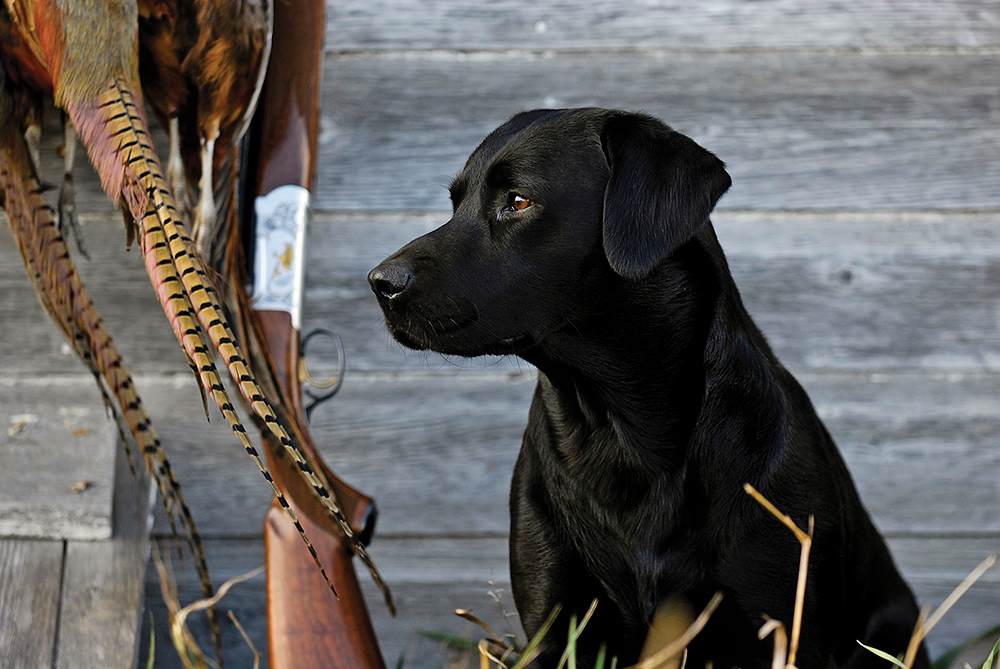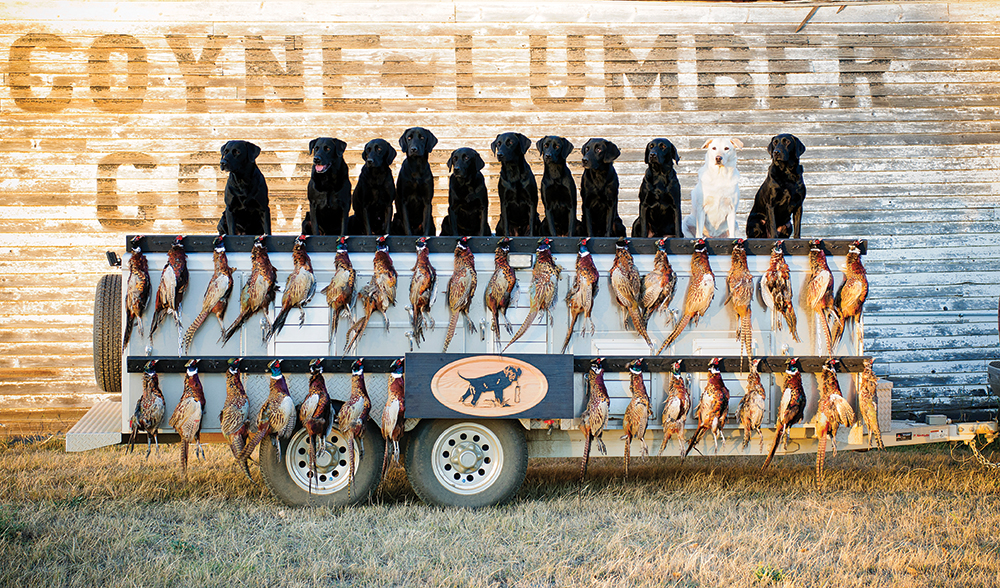DOGS OF DUALITY

Epiphanies are confounding. You never know you’re going to have one, right up until the moment you do. They can’t be summoned, predicted, or carefully constructed from the sturdy building blocks of logic, reason, or common sense. The sprites of true inspiration are mercurial, and they hit you at the time and place of their choosing. For Mike Stewart, that moment came in the middle of a Mississippi farm pasture sometime in the early 1990s, standing next to a guy dressed like Colonel Sanders.
Back then, Stewart wasn’t the owner of one of the most famous gun-dog kennels in the nation, with three different training facilities, a six-figure revenue stream, a year-long waiting list for one of his dogs, a slew of endorsement deals with groups like Ducks Unlimited, a training book, DVDs, a long list of millionaire clients, and profiles in magazines like Forbes. He was just a guy who had some radical ideas about training dogs and loved applying those ideas in a small side business to his day job as the police chief of the nearby University of Mississippi. And that’s exactly what he was doing when an epiphany walloped him.
“I was standing there with a guy who had driven down from Nashville because he wanted me to train his retriever and his pointer to work together,” recalls Stewart. “He was one of those true Southern gentleman types, he even wore a white suit.” And as his genteel client watched Stewart train his dogs, he uttered the words that would set Mike Stewart on his current path: “Mike, what you train are gentleman’s gun dogs.”
“That was really the start of it all,” says Stewart. “That’s the market I decided on—well-mannered dogs you could live and travel with. What I like to call ‘dogs of duality.’”
And the rest, as we all say, is history. Stewart’s Wildrose Kennels, which was founded in 1972 by Robert Milner and bought by Stewart in 1999, has grown from a small kennel specializing in imported British Labrador retrievers into a genuine phenomenon, one Stewart and his many acolytes simply call “The Wildrose Way.” How did a self-described “retired cop” become master of a burgeoning dog-breeding and training empire?

Stewart earned his first dog-training dollars when he was 14, teaching whoa to pointers for five bucks a pop. Upon his college graduation, when others were getting motorcycles or cars, Stewart asked for a Llewellin setter. “My dad got him for me,” he says, “mainly because I think he was surprised I actually made it through to graduate college.”
From there Stewart got his first Lab, and in 1972 he first started offering dog training in Oxford. “I started out retriever training and also obedience-training German shepherds, and then later got pretty heavy into the competitive beagle field-trial scene. That kinda burned me out on the whole competitive-dog-game scene for a while,” he says.
In 1988, Stewart bought a 143-acre farm near Oxford and began transforming it into a training facility. His dog-training business at that time was more of a hobby than a full-time operation, but he was developing the no-force positive-reinforcement training techniques and philosophies that would eventually become the famed “Wildrose Way.”
Mike Stewart had his target market. He had his training process. He had his vision of the perfect gun dog. Now all he needed was an opportunity to put it all together. That opportunity came in 1999, when Stewart purchased the name and assets of Wildrose Kennels. Founded in Grand Junction, Tennessee, in 1972 by a man named Robert Milner, Wildrose had been instrumental in introducing the British Labrador and British-training concepts to the American hunting scene. For Stewart, it was a perfect fit.
“Back then I was seeing more and more problems with the dogs coming out of the American field trials,” says Stewart. “At the same time I had started getting more and more British Labs, and I really liked them.” For Stewart, the calm, gentle, intelligent, and supremely tractable nature of the British Labs was a perfect fit for his training philosophy. “That’s why I favor British Labs,” says Stewart. “Because you can get them to do most anything.”

Stewart relocated the Wildrose operation to Oxford and set about expanding and perfecting the business. The Wildrose Way was born.
And what is the Wildrose Way? Surprisingly, it’s as much about training humans as it is about training dogs. Stewart’s methods employ no negative reinforcement, no e-collars, and no breaking. Instead, Stewart chooses to focus on positive reinforcement, gentle repetition, and imprinting what he calls “essential behaviors” to the point of habit formation. The result, says Stewart, is a well-behaved gun dog; and, perhaps more important, one that stays well-behaved for a lifetime.
It must be working, because you will find Mike Stewart’s dogs in all 50 states, all over Canada, and in a number of foreign countries. You’ll see them in magazines, on television, in duck blinds, the uplands, on boats, hiking trails. and in your neighborhood boutique. (One of the “final exams” for all of Stewart’s $15,000, fully-trained finished gun dogs is a shopping trip to town designed to test their calmness.)
Stewart’s dogs aren’t cheap, at north of a thousand bucks for a seven-week-old pup and going up from there for started and finished gun dogs; but there is no shortage of willing buyers waiting to take one home. However, if you want a Wildrose dog, be prepared to wait upwards of a year for the pleasure; a fully-finished gun dog is a two-to-three year time commitment.
But gun dogs are not the only canine companion Wildrose offers. In recent years, Stewart has been perfecting both his breeding and training regimens to encompass what he calls “adventure dogs.”
“Hunting dogs are still our mainstay,” says Stewart, “but there are a lot of people out there who are not involved in the shooting sports, but want a canine companion that exhibits all the traits, the calm nature, the intelligence, and the obedience of our gun dogs.” Enter the “adventure dog.”

“Hiking, biking, boating people are looking for dogs that are essentially sporting companions, and we can tailor the dog’s training to pretty much anything the client wants,” he says. With companion and adventure dogs making up 15 percent of Stewart’s clients, he says “It’s actually the fastest-growing part of our business.”
Stewart employs four full-time trainers at his main Oxford, Mississippi, training facility, plus a number of associate trainers scattered throughout the country and at his other two training locations: one in Arkansas where dogs are trained in river environments; the other in Colorado, where dogs are introduced to higher-altitude mountain settings. In addition, Stewart also has a diabetic-alert-dog training program, in which his dogs are trained to detect blood-sugar levels in their owners.
But no matter if a dog is ultimately destined for the field, the kayak, or the home, they all start out the same way. “Any puppy program needs to have a good foundation before the seven-week mark, and we start working with our pups when they’re about three days old with both stimulation and scent introductions, things like whistles, decoys, tunnels, mazes, wing-tracking,” Stewart says.
While the foundation genetics of Stewart’s dogs are British and Irish bloodlines, these days most of the dogs he breeds are his own. “We’re in our third generation of dogs now,” says Stewart. “What we’re doing is developing our own distinct line of dogs.”
The goal, says Stewart, is to be able to produce a dog custom-tailored to whatever the client wants. “It’s like a gun,” he says. “You can go buy a gun off the shelf, or you can order a fine, bespoke gun to fit you. And that’s what we’re doing here. We’re custom-building fine, bespoke dogs.”

“Any puppy program needs to have a good foundation before the seven-week mark, and we start working with our pups when they’re about three days old with both stimulation and scent introductions, things like whistles, decoys, tunnels, mazes, wing-tracking,” Stewart says.
























